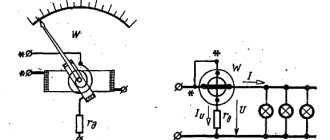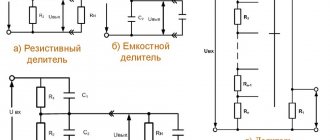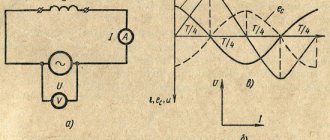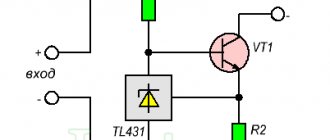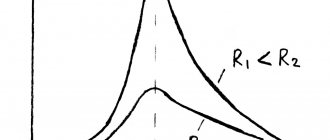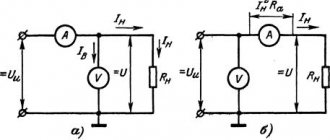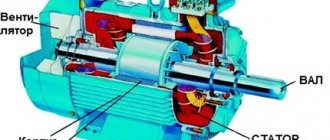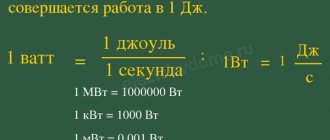What is current strength?
Electric current is the ordered movement of charged particles inside a conductor with the obligatory presence of a closed circuit.
The appearance of current is due to the movement of electrons and free ions that have a positive charge.
As they move, charged particles can heat the conductor and have a chemical effect on its composition. In addition, the current can influence neighboring currents and magnetized bodies.
Current strength is an electrical parameter that is a scalar quantity. Formula:
I=q/t, where I is current, t is time, and q is charge.
It is also worth knowing Ohm's law, according to which current is directly proportional to U (voltage) and inversely proportional to R (resistance).
I=U/R.
There are two types of current - positive and negative.
Below we will consider what this parameter depends on, how to increase the current strength in the circuit, in the generator, in the power supply and in the transformer.
We will provide proven recommendations that will allow you to solve your problems.
What does current strength depend on?
To increase I in a circuit, it is important to understand what factors can influence this parameter. Here we can highlight the dependence on:
- Resistance. The smaller the parameter R (Ohm), the higher the current in the circuit.
- Voltages. Using the same Ohm's law, we can conclude that as U increases, the current strength also increases.
- Magnetic field strength. The larger it is, the higher the voltage.
- Number of coil turns. The greater this indicator, the greater U and, accordingly, the higher I.
- The power of the force that is transmitted to the rotor.
- Diameter of conductors. The smaller it is, the higher the risk of heating and burning out the supply wire.
- Power supply designs.
- The diameter of the stator and armature wires, the number of ampere-turns.
- Generator parameters - operating current, voltage, frequency and speed.
Variation - Frequency - Current
Changing the frequency of the current, even within small limits, affects the operation of electrical receivers and electrical networks. Thus, for asynchronous and synchronous electric motors with a constant torque on the shaft, the rotation speed, and therefore the performance, changes almost proportionally to the change in the frequency of the electric current. [1]
Changing the frequency of the current supplying the pusher motor is achieved by connecting this motor to the rotor of the motor of the working mechanism. The frequency and voltage of the rotor current of the mechanism motor are inversely proportional to its rotation speed; at the moment the engine starts, the rotor current frequency is equal to the rated frequency; at full speed, the current frequency is minimal. According to the change in the rotor current, the pusher force and the amount of braking torque developed by the brake change. At the first moment of starting, when the rotor current frequency is maximum, the brake is completely open and the mechanism picks up speed. [2]
Regulation by changing the frequency of the supply current has become increasingly widespread in recent years due to the development and improvement of thyristor converters. The main disadvantage of this method, along with the high cost of the converter itself, a slight decrease in the reliability of the entire installation and an increase in its dimensions, is the non-sinusoidal current at the output of the converter, which is reflected in the technical indicators of the IM. [3]
How to increase the current in a circuit?
There are situations when it is necessary to increase I, which flows in the circuit, but it is important to understand that measures need to be taken to protect electrical appliances; this can be done using special devices.
Let's look at how to increase the current using simple devices.
To complete the work you will need an ammeter.
Option 1.
According to Ohm's law, current is equal to voltage (U) divided by resistance (R). The simplest way to increase force I, which suggests itself, is to increase the voltage supplied to the input of the circuit, or to reduce the resistance. In this case, I will increase in direct proportion to U.
For example, when connecting a 20 Ohm circuit to a power source with U = 3 Volts, the current value will be 0.15 A.
If you add another 3V power source to the circuit, the total value of U can be increased to 6 Volts. Accordingly, the current will also double and reach a limit of 0.3 Amperes.
The power supplies must be connected in series, that is, the plus of one element is connected to the minus of the first.
To obtain the required voltage, it is enough to connect several power sources into one group.
In everyday life, constant U sources combined into one group are called batteries.
Despite the obviousness of the formula, practical results may differ from theoretical calculations, which is due to additional factors - heating of the conductor, its cross-section, the material used, and so on.
As a result, R changes towards an increase, which leads to a decrease in force I.
Increasing the load in the electrical circuit can cause overheating of the conductors, burnout, or even a fire.
That is why it is important to be careful when operating devices and take into account their power when choosing a cross-section.
The value of I can be increased in another way by reducing the resistance. For example, if the input voltage is 3 Volts and R is 30 Ohms, then a current of 0.1 Ampere passes through the circuit.
If you reduce the resistance to 15 Ohms, the current strength, on the contrary, will double and reach 0.2 Amperes. The load is reduced to almost zero during a short circuit near the power source, in this case I increases to the maximum possible value (taking into account the power of the product).
Resistance can be further reduced by cooling the wire. This effect of superconductivity has long been known and is actively used in practice.
To increase the current in a circuit, electronic devices are often used, for example, current transformers (as in welders). The strength of variable I in this case increases with decreasing frequency.
If there is active resistance in the AC circuit, I increases as the capacitance of the capacitor increases and the inductance of the coil decreases.
In a situation where the load is purely capacitive in nature, the current increases with increasing frequency. If the circuit includes inductors, the force I will increase simultaneously with the decrease in frequency.
Also read - how electric current acts on the human body.
Option 2.
To increase the current strength, you can focus on another formula, which looks like this:
I = U*S/(ρ*l). Here we only know three parameters:
- S—wire cross-section;
- l is its length;
- ρ is the electrical resistivity of the conductor.
To increase the current, assemble a chain containing a current source, a consumer and wires.
The role of the current source will be performed by a rectifier, which allows you to regulate the EMF.
Connect the chain to the source, and the tester to the consumer (pre-set the device to measure current). Increase the EMF and monitor the indicators on the device.
As noted above, as U increases, it is possible to increase the current. A similar experiment can be done for resistance.
To do this, find out what material the wires are made of and install products that have lower resistivity. If you cannot find other conductors, shorten the ones already installed.
Another way is to increase the cross-section, for which it is worth mounting similar conductors parallel to the installed wires. In this case, the cross-sectional area of the wire increases and the current increases.
If we shorten the conductors, the parameter we are interested in (I) will increase. If desired, options for increasing the current can be combined. For example, if the conductors in the circuit are shortened by 50% and U is raised by 300%, then the force I will increase 9 times.
Why use VFD AC Frequency Drive?
Reducing energy consumption and electricity costs.
If you have an application that does not require constant operation at maximum speed, you can reduce energy costs by controlling the motor with a variable frequency drive, which is one of the benefits of variable frequency drives. The VFD AC drive allows you to match the motor speed to the required load. There is currently no other, more efficient way to control an AC motor that will accomplish this.
Currently, electric motors consume more than 65% of global energy consumption. Optimization of engine control systems through the use of frequency converters can reduce energy consumption in some cases by up to 70%. In addition, the use of a frequency converter improves product quality and reduces production costs.
Increased production due to tighter control of technological processes.
How to increase the current in the power supply?
On the Internet you can often come across the question of how to increase I in the power supply without changing the voltage. Let's look at the main options.
Situation No. 1.
A 12 Volt power supply operates with a current of 0.5 Amperes. How to raise I to its maximum value? To do this, a transistor is placed in parallel with the power supply. In addition, a resistor and stabilizer are installed at the input.
Find out more - how to check a transistor with a multimeter for serviceability.
When the voltage across the resistance drops to the required value, the transistor opens, and the rest of the current flows not through the stabilizer, but through the transistor.
The latter, by the way, must be selected according to the rated current and a radiator installed.
In addition, the following options are possible:
- Increase the power of all elements of the device. Install a stabilizer, a diode bridge and a higher power transformer.
- If there is current protection, reduce the value of the resistor in the control circuit.
Situation No. 2.
There is a power supply for U = 220-240 Volts (at the input), and at the output a constant U = 12 Volts and I = 5 Amperes. The task is to increase the current to 10 Amps. In this case, the power supply should remain approximately the same dimensions and not overheat.
Here, to increase the output power, it is necessary to use another transformer, which is converted to 12 Volts and 10 Amps. Otherwise, the product will have to be rewound yourself.
In the absence of the necessary experience, it is better not to take risks, because there is a high probability of a short circuit or burnout of expensive circuit elements.
The transformer will have to be replaced with a larger product, and the damper chain located on the DRAIN of the key will also have to be recalculated.
The next point is replacing the electrolytic capacitor, because when choosing a capacitance you need to focus on the power of the device. So, for 1 W of power there are 1-2 microfarads.
It is also recommended to change the diodes with rectifiers. In addition, it may be necessary to install a new rectifier diode on the low side and increase the capacitor capacity.
After such a modification, the device will heat up more, so installing a fan is not necessary.
Operating principle of the frequency converter
The operating principle of the frequency converter is based on the operating features of an asynchronous electric motor. In an electric motor of this type, the rotation frequency of the magnetic field (n1 value) depends on the frequency of the supply voltage. In the case when the stator winding is powered by a three-phase voltage having a frequency f, a rotating magnetic field is generated, the rotation speed of which is determined by the formula below:
, Where
p is the number of pairs of stator poles.
The transition from the field rotation speed ω1, which is measured in radians, to the rotation frequency n1 (rpm), is performed according to the formula:
, Where
60 is the dimension conversion factor.
If we substitute the field rotation speed ω1 into this equation, we obtain the following equality:
From this it is easy to conclude that the rotor speed of an asynchronous electric motor depends on the frequency of the supply network voltage. It is this dependence that reflects the whole essence of the frequency regulation method. The frequency converter for the electric motor changes the frequency of the supply voltage at the input and, as a result, regulates the rotor speed. We emphasize that the output frequency in modern frequency converters varies over a wide range, which means that this value can be either lower or higher than the frequency of the supply network.
The frequency converter for the electric motor, the principle of operation of the power unit of which formed the basis for the classification below, corresponds to the following parameters:
- Converters with a clearly defined intermediate DC link.
- Converters with direct coupling (no intermediate DC link).
By historical standards, direct-coupled frequency converters were the first to appear. In these units, the power part is a controlled rectifier made using thyristors. The control node, in turn, unlocks groups of thyristors, thereby generating an output signal. Today this conversion method is not used in new developments.
How does this class of converter work? Here, double conversion of electricity is used: the input sinusoidal voltage (values L1, L2, L3 in the figure) with a constant amplitude/frequency is rectified in the rectifier unit (BR), filtered and smoothed in the filtering unit (BF), as a result, we obtain a constant voltage. The presented unit is called the DC link.
The conversion unit (BD) is responsible for solving the problems of generating a sinusoidal alternating voltage with an adjustable frequency. The role of electronic switches that generate the output signal is performed by bipolar transistors with an insulated gate IGBT. The process of controlling the above blocks occurs according to a pre-programmed algorithm by a microprocessor module or logical block (BL).
We advise you to study How to distinguish a battery from a rechargeable battery
The diagram below shows that frequency converters can be powered from an external DC link. In this case, the protection of the frequency generator is carried out using high-speed fuses
It is important to note that the use of contactors for DC link power is not recommended. The fact is that during contactor switching, an increased charging current occurs and the fuses can burn out
How to increase the current in the charger?
When using chargers, you may notice that chargers for a tablet, phone or laptop have a number of differences. In addition, the speed at which devices are charged may also vary.
Here a lot depends on whether an original or non-original device is used.
To measure the current that goes to your tablet or phone from the charger, you can use not only an ammeter, but also the Ampere app.
Using the software, it is possible to determine the charging and discharging speed of the battery, as well as its condition. The application is free to use. The only drawback is advertising (the paid version does not have it).
The main problem with charging batteries is the low current of the charger, which is why the time to gain capacity is too long. In practice, the current flowing in the circuit directly depends on the power of the charger, as well as other parameters - cable length, thickness and resistance.
Using the Ampere application, you can see at what current the device is charged, and also check whether the product can charge at a higher speed.
To use the capabilities of the application, just download it, install and run it.
After this, the phone, tablet or other device is connected to the charger. That's all - all that remains is to pay attention to the current and voltage parameters.
In addition, you will have access to information about the battery type, U level, battery condition, as well as temperature conditions. You can also see the maximum and minimum I that occur during the cycle.
If you have several chargers at your disposal, you can run the program and try charging each of them. Based on the test results, it is easier to select a charger that provides the maximum current. The higher this parameter is, the faster the device will charge.
Current measurement isn't the only thing Ampere can do. With its help, you can check how much I is consumed in standby mode or when turning on various games (applications).
For example, after turning off the display brightness, deactivating GPS or data transfer, it is easy to notice a decrease in load. Against this background, it is easier to conclude which options drain the battery the most.
What else is worth noting? All manufacturers recommend charging devices with “native” chargers that produce a certain current.
But during operation, there are situations when you have to charge your phone or tablet with other chargers that have more power. As a result, the charging speed may be higher. But not always.
Few people know, but some manufacturers limit the maximum current that the device’s battery can accept.
For example, a Samsung Galaxy Alpha device comes with a 1.35 Ampere charger.
When connecting a 2-amp charger, nothing changes - the charging speed remains the same. This is due to a limitation set by the manufacturer. A similar test was carried out with a number of other phones, which only confirmed the guess.
Taking into account the above, we can conclude that non-native chargers are unlikely to cause harm to the battery, but can sometimes help with faster charging.
Let's consider another situation. When charging a device via a USB connector, the battery gains capacity more slowly than when charging the device from a conventional charger.
This is due to the limitation of the current that a USB port can supply (no more than 0.5 Ampere for USB 2.0). When using USB3.0, the current increases to 0.9 Ampere.
In addition, there is a special utility that allows the “troika” to pass a larger I through itself.
For devices like Apple, the program is called ASUS Ai Charger, and for other devices - ASUS USB Charger Plus.
Design. Types of converters
A frequency electric drive has a number of circuits that include a transistor or thyristor. The basic element of the electronic circuit is a microprocessor, which is responsible for the operation of additional circuit elements and ensures the performance of a large number of additional tasks.
A frequency converter is a group of rectifiers, as well as inverters that transform alternating currents into direct currents.
Single-phase frequency converter is a high-tech device. Its main task is to convert the operating voltage of the network into household voltage (220 V). With this transformation, a voltage pulse is performed at the required frequencies (1 – 1000) Hz.
The frequency converter for the electric motor creates voltages with the specified parameters. The frequency converter works as follows:
- First, the voltage of the electrical network is rectified, as well as pulse reduction and harmonic filtering.
- DC voltage is supplied from the rectifier to the inverter circuit, where it is transformed into alternating voltage with varying amplitude and frequency.
Fig. 1 Schematic diagram of a frequency converter
The role of power elements is often performed by IGVT transistors. By changing the frequency, you can change the rotation speed of the electric motor (M).
The frequency converter is divided into two large types:
With direct communication.
Their distinctive feature is a thyristor rectifier, where individual thyristors alternately open and close and are alternately connected to the stator coil.
Rice. 2 Graphical representation of the converter voltage
The output voltage of the sinusoid forms a sawtooth shape with a frequency of about 1 – 40 Hz. The scope of application of this kind of converters is considered limited due to the fact that non-lockable thyristors require more complex control circuits. Which brings with it a higher cost of equipment.
Such frequency converters operating with high currents and voltages have an efficiency of about 95-98%. Also, high-voltage frequency converters have a higher cost compared to low-voltage ones.
If we compare a thyristor converter with a transistor electric drive that has similar power, then the second device will have significantly smaller dimensions, lighter weight and will be more reliable.
With a pronounced DC link.
This type of sensor is much more common in modern devices whose purpose is to regulate frequency.
The transformation occurs in 2 stages:
- first, the mains voltage is rectified and filtered;
- then the signal is supplied directly to the inverter, where the current of the required frequencies and amplitudes is transformed into alternating current.
We advise you to study Load Break Switch
The efficiency of such a transformation decreases, while the dimensions of the device increase. The sinusoidal signal is provided by an independent voltage and current inverter.
How to increase the current in a transformer?
Another question that worries electronics enthusiasts is how to increase the current strength in relation to the transformer.
Here are the following options:
- Install a second transformer;
- Increase the diameter of the conductor. The main thing is that the cross-section of the “iron” allows it.
- Raise U;
- Increase the cross-section of the core;
- If the transformer operates through a rectifier device, it is worth using a product with a voltage multiplier. In this case, U increases, and with it the load current also increases;
- Buy a new transformer with a suitable current;
- Replace the core with a ferromagnetic version of the product (if possible).
A transformer has a pair of windings (primary and secondary). Many output parameters depend on the wire cross-section and the number of turns. For example, there are X turns on the high side and 2X on the other side.
This means that the voltage on the secondary winding will be lower, as will the power. The output parameter also depends on the efficiency of the transformer. If it is less than 100%, U and the current in the secondary circuit decrease.
Taking into account the above, the following conclusions can be drawn:
- The power of the transformer depends on the width of the permanent magnet.
- To increase the current in the transformer, a decrease in R load is required.
- The current (A) depends on the diameter of the winding and the power of the device.
- In case of rewinding, it is recommended to use thicker wire. In this case, the wire mass ratio on the primary and secondary windings is approximately identical. If you wind 0.2 kg of iron on the primary winding and 0.5 kg on the secondary winding, the primary will burn out.
How to increase the current in the generator?
The current in the generator directly depends on the load resistance parameter. The lower this parameter, the higher the current.
If I is higher than the nominal parameter, this indicates the presence of an emergency mode - frequency reduction, generator overheating and other problems.
For such cases, protection or disconnection of the device (part of the load) must be provided.
In addition, with increased resistance, the voltage decreases, and U increases at the generator output.
To maintain the parameter at an optimal level, regulation of the excitation current is provided. In this case, an increase in the excitation current leads to an increase in the generator voltage.
The network frequency must be at the same level (constant).
Let's look at an example. In a car generator, it is necessary to increase the current from 80 to 90 Amperes.
To solve this problem, you need to disassemble the generator, separate the winding and solder the lead to it, followed by connecting the diode bridge.
In addition, the diode bridge itself is changed to a part with higher performance.
After this, you need to remove the winding and a piece of insulation in the place where the wire is to be soldered.
If there is a faulty generator, the lead is bitten off from it, after which the legs of the same thickness are built up using copper wire.
After soldering, the joint is insulated with heat shrink.
The next step is to buy an 8-diode bridge. Finding it is a very difficult task, but you have to try.
Before installation, it is advisable to check the product for serviceability (if the part is used, a breakdown of one or more diodes is possible).
After installing the bridge, attach the capacitor, and then a 14.5-volt voltage regulator.
You can purchase a pair of regulators - 14.5 (German) and 14 Volts (domestic).
Now the rivets are drilled out, the legs are unsoldered and the tablets are separated. Next, the tablet is soldered to a domestic regulator, which is fixed with screws.
All that remains is to solder the domestic “pill” to the foreign regulator and assemble the generator.
How to change AC frequency
Dear Cats. Tell a beginning kitten where to look (from theory to practice) how to change the frequency of the current? Thank you very much in advance!
Best regards, beginner kitten.
JLCPCB, only $2 per PCB prototype! Any colour!
Register and receive two coupons for $5 each: https://jlcpcb.com/cwc
PCB Assembly from $30 + FREE Shipping Worldwide + Stencil
Possessio There are frequency multipliers/dividers, but they are mainly used in digital technology. Moreover, there are much more problems with the former than with the latter. And the simplest option was already recommended by aen - this is a generator. So the question is still unclear. Is the output voltage needed to power something (a power circuit), or is it just some kind of signal?
Stalker46 , read more carefully, a person needs to change the frequency, not change R It
and Analog Devices invite everyone to participate in a webinar on 04/27/2021 on Analog Devices galvanic isolation solutions. The webinar program includes: iCoupler galvanic isolation technologies, digital isolators, isoPower technology, galvanically isolated interfaces (RS-485, CAN, USB, I2C, LVDS) and more. The webinar will be of interest to developers of industrial automation and medical equipment.
The wide range of Degson screw terminal blocks includes various variations with pin pitches from 2.54 to 15 mm, with the number of tiers from one to three and conductor connection angles of 45°, 90°, 180°. In addition, Degson offers a fairly large selection of screw terminal blocks in custom colors.
So we want to get from you, what exactly is needed?
Well, for example, there is a transformer at 50 Hz, you need to power the engine at 400 Hz - this is one thing, building a radio transmitter with multiplying the frequency of the master oscillator is completely different, but installing a digital counter for dividing the frequency of the signal (logical levels) is quite another.
